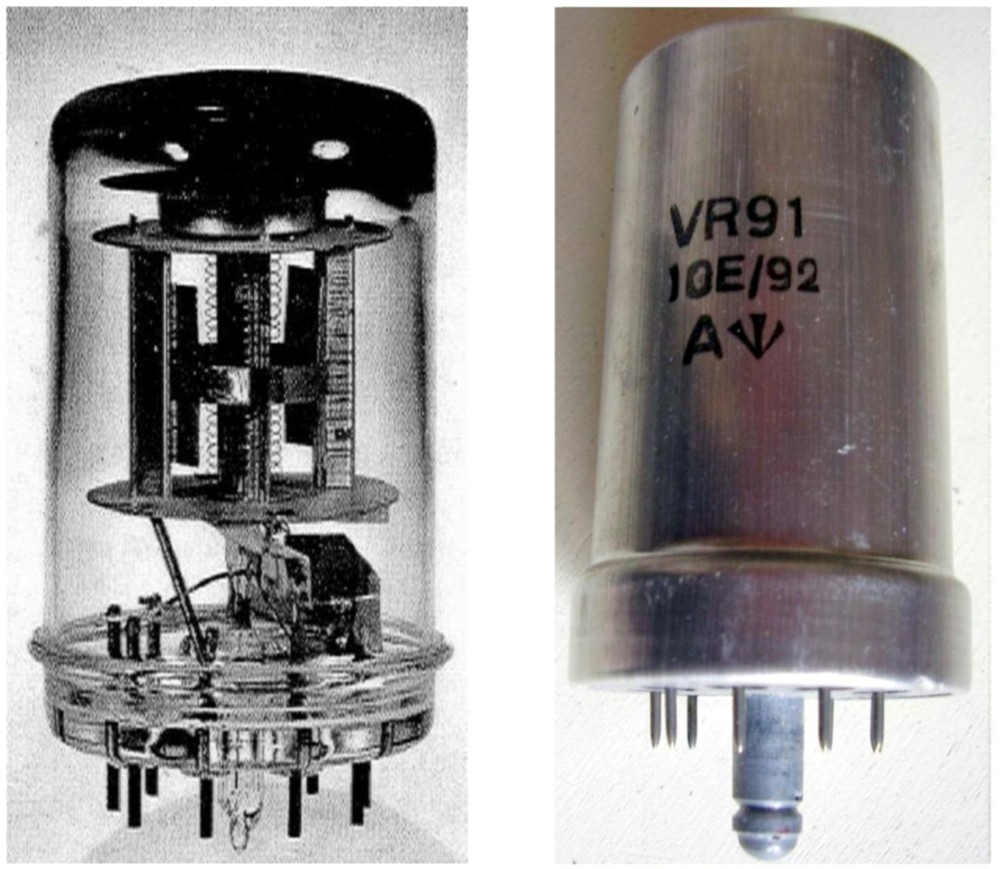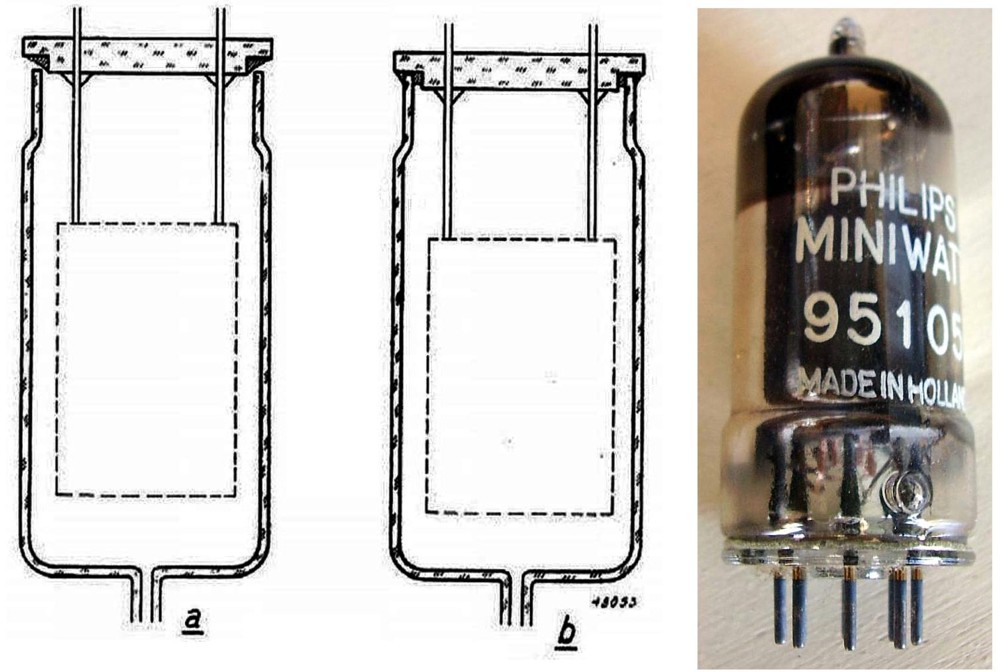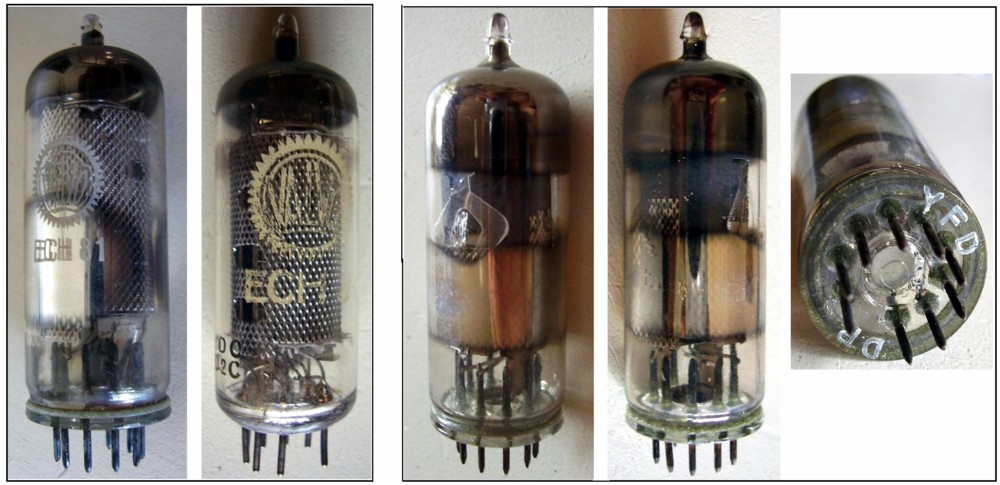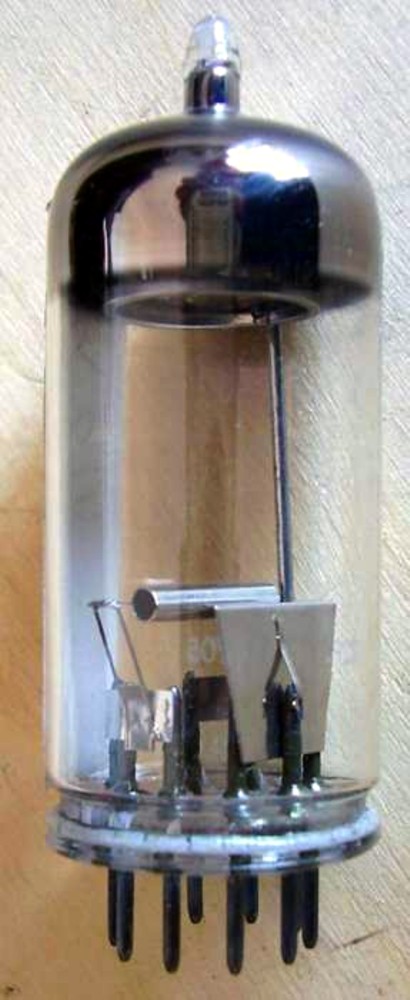Early Philips Noval Tubes, also advertised as ‘Innovals’
Early Philips Noval Tubes, also advertised as ‘Innovals’

Even before WWII Philips had developed its own all-glass tubes for the emerging TV market. Removing the bakelite base resulted in lower inductance and capacitance of leads, thus increasing the useful frequency. EF50, the result of early design efforts, was the most appreciated amplifier for radar applications in Great Britain during WWII and later.
Fig. 1 - Internal construction of EF50 VHF pentode and VR91, one of the many British derivatives, with metal shielding can over the glass body. The exhaust tube in the middle of the base is protected by a metal spigot with the polarizing key and the locking head.
The next step at Philips was the introduction of tubes for portable sets, with miniature all-glass envelope. In America RCA had introduced its family of 7-pin B7G miniature tubes in 1939. The Philips answer was the 8-pin rimlock family. With its 22 mm diameter and the 8-pin base, this family could easily accomodate electrode assemblies of old tubes with side-contact European base, up to the power output pentodes. To prevent bending of pins at the insertion in the socket, a guide stud was embossed in the glass body, near to the base, or in a metal collar.
Fig. 2 - Left, the sealing of the base and electrode assembly against the envelope using a precision low-temperature ‘glazing’ or frit seal process. Right a rimlock tube, showing the embossed guide stud.
The corresponding socket was fitted with a metal collar with a guide and a spring lock for the polarizing stud. The design choices and the processes were all selected for the highest reliability of the tubes in every applications. The hard metal pins were rigid enough and just a few of them firmly held the electrode pack centered in the bulb, no need for large mica spacers pressed against the bulb internal wall. The low sealing temperature did not soften the bulb or the base glass button, granting the precise alignement of pins and of electrodes. The cathode poisoning due to high temperature oxidation was very low. A description of the solutions and of the characteristics of rimlock tubes can be found in this Philips article from 1946.
Rimlock tubes were widely accepted by European radio manufacturers but had two drawbacks against the emerging noval types, they were expensive and had only eight pins. When regular FM programs started in Europe in the early fifties, the new multi-unit tube 6T8 was introduced in America as FM/AM detector/discriminator and low-level audio amplifier. Likely this tube was the Trojan horse that forced Philips to switch to noval tubes in a few years. In AM/FM radios 6T8 alone could replace a couple of rimlock tubes, the EAF42 AM detector and amplifier and the EB41 FM discriminator. From about 1952 Philips started supplying its European customers with mixed kits including rimlock types and EABC80, the European code for 6T8. Another noval tube, the 12AT7, proved to be widely accepted to replace the couple of EF42 previously used in FM tuners, as mixer and local oscillator.
For some years, about from 1951 to 1954, we see a mix of rimlock and noval tubes, at least in the low-level stages of European radio sets. The table below shows the tube line-up for some German AM/FM radio models.
|
Mfr. & model |
Year |
Tube line-up (magic eyes and rectifiers not included) |
|
Graetz 154W |
1951-1952 |
EF42, EF42, ECH42, EBF80, EB41, EF43, EL41 |
|
Graetz 156W |
1952-1953 |
EF42, EF42, ECH42, EF41, EAF42, EB41, EF41, EL11 |
|
Graetz 160W |
1952-1953 |
ECC81, ECH81, EF85, EABC80, EL41, AZ41 |
|
Graetz 176W |
1953-1954 |
EC92, EC92, EF41, ECH81, EF41, EABC80, EC92, EL84, EL84 |
|
SABA Meersburg |
1952-1953 |
EF80, EC92, ECH81, EF85, EABC80, EL34 |
|
SABA Bodensee |
1953-1954 |
EF80, EC92, ECH81, EF41, EAF42, EABC80, EL12 |
|
TeKaDe Melodie W387 |
1953 |
EC92, EC92, ECH81, EF41, EF41, EABC80, EL41 |
Certainly Philips and its related brands sold noval tubes to their customers in Europe in the early 1950s. Looking inside the old AM/FM German radios listed in the table above, we had the surprise to find here and there a quite special type of noval tubes. They look very similar in construction to rimlock tubes, with the sharp-edged base glazed to the envelope. The electrode system is directly welded to some of the pins, no large mica spacers pressed against the glass wall. We must assume that at the beginning Philips delivered few types of noval tubes only to those strategic customers where American competitors were pressing hardly, offering them full noval line-up. Likely early productions were run on the same lines of the rimlock types, using the same processes and maybe in some cases the same electrode assemblies. From the codes printed on the glass of the base we learn that these noval tubes, advertised in the early fifties as ‘innovals’, were made at Mullard Blackburn, at Valvo Hamburg and at Wiener Radio Werke.
We can assume that even earlier productions were launched in countries closer by trade relations to America, as Australia or Canada. Unfortunately we do not have evidences of glazed tubes from overseas countries but certainly the RMorg community will fill this gap very soon.
Here some examples of the early Philips ‘glazed’ noval tubes.
Fig. 3 - Samples of very early European EABC80s. The first one is branded TeKaDe while the second and the third ones are branded Valvo. All have Y4B short code printed on the base, indicating they were pumped at the Mullard Blackburn plant in England. In the three samples above the base is glazed to the envelope by low temperature sealing process and the electrode assembly is held rigidly by a couple of rods well visible in the first photo, no need for mica spacers. The last sample on the right is the normal noval version.
Fig. 4 - Two images of an early glazed version of European ECC81 /12AT7. Although Valvo branded, its short code Y4B printed on the base suggests it was pumped at British Mullard. The mica spacers are well spaced from the bulb and the electrode assembly is directly welded to a few pins. The last sample is a normal 12AT7.
Fig. 5 - Two more early noval tubes from Philips related plants. On the left an early glazed ECH81 frequency converter near to a later noval sample. From center to right three images of a glazed EF80 pumped at Valvo, Hamburg.
Fig. 6 - Two images of an early glazed EF85. According to the short code stamped on the base, Y3A, this sample was pumped at Wiener Radio Werke.
Glazed noval tubes can be no longer found in radio sets approximately manufactured from 1953. Nevertheless some professional types survived even later in their glazed version, probably because their low volumes did not justify a redesign of the electrode assembly.
Fig. 7 - A temperature limited diode, the K81A, intended for use as noise generator. Assembled with base glazing technique.
Everyone could find some glazed noval tubes inside his old radio, if it was build in the early fifties using European tubes. It would be interesting to have a complete list of tubes made to this technology, maybe including power tubes as the EL84. Frit seal novals can also be proposed as ‘glazed’ variants of the base types.
To thank the Author because you find the post helpful or well done.
Innoval tubes: The Australian birth

Martin Kent, an Australian member of Radiomuseum, kindly provided the attached Booklet on ‘Innoval tubes’
The booklet, by Australian Philips, was printed in the early 1949, since the enclosed datasheets are all dated 1.11.49. It clearly states that ‘innovals’, that is a neologism for the very early Philips ‘innovative novals’, were born from the combined efforts of Australian Philips and the Eindhoven parent company. The drawbacks of the pinched manufacturing process as well as the benefits of modern processes, as that used in the 8-pin rimlock family and fully transferred to the new 9-pin envelope, are summarized in the first pages. The document gives images, even on the construction, and plenty of information about four of the new innoval tubes, which look to be rebased versions of rimlock types proposed for AM receivers. Then it gives complete datasheets of eight tube types, likely the entire family of innoval tubes already available at the date in the Philips group.
- 6AN7, European code ECH80, was a triode hexode frequency converter intended for use in AM radio designs. It was only used in Australia from 1949 to the late sixties. We see a spot use in France in 1958, likely based upon a Mazda production of the tube.
- 6BD7, European code EBC81, was a twin diode / triode, intended as detector and audio low-level amplifier in AM radio sets. 6BD7 was used only in Australia up to 1966. EBC81 was widely used in Europe but only from 1954 upwards.
- 6BE7 was an enneode intended as FM demodulator. It found no use at all in Australia. Its equivalent EQ80 was used in Europe in a few radio sets through the first half of fifties
- 6M5, European equivalent EL80, was widely used in Australia as audio power amplifier until the late sixties. It was virtually unknown in the rest of the world.
- 6N8, European code EBF80, was a twin diode / triode widely used both in Australia and in Europe. We also find a niche European production as 6N8 in France, by Mazda.
- 6Q4 was a VHF triode, likely introduced for applications in the television front-end. No use in Australia or in US. Its European equivalent EC80 found some applications in high-frequency instrumentation.
- 6R4 was an UHF triode, likely intended as oscillator in television front ends. No known use as such. The European equivalent EC81 was used in a few German high frequency instruments by Rohde & Schwarz and Siemens.
- 18042 was a low-noise amplifier for telephone repeaters which just found a few applications in some German instruments.
Reading of the booklet reveals interesting details about the birth of the noval tubes in Philips. Although it was printed in Australia, the new technology appears to have been developed in Eindhoven. Almost certainly Australia played its role specifying or even participating to the design of the four types intended for Australian AM radio sets, 6AN7, 6BD7, 6M5 and 6N8. Examining the RMorg archives we see that, despite their RMA registration in US, no known use was made of them in North America. Looking to their European equivalents, we find that the ECH80 and EL80 were never used by radio manufacturers in Europe. With great surprise we find just one photo of ECH80 and no images at all of the EL80: likely it was never even made in Europe. On the contrary EBC81 and EBF80 were used in Europe, but the diffusion of EBC81 began from 1954, when the glazed seal had already been discontinued.
We must assume that the remaining four types were the first noval tubes designed in Eindhoven for emerging markets between 1948 and the very early 1949: EQ80 was intended as limiter/detector for FM radio, EC80 and EC81 as high-frequency amplifier and oscillator for UHF television and the 18042 as low-noise telephony amplifier.
Then we can say that likely in 1949 Philips had defined processes for building noval tubes as variants of the rimlock family. Very early noval tubes were designed in Eindhoven for emerging markets. Australia was then selected as the ideal area in which to experiment volume productions of the new tubes: far enough from America to be influenced by US direct competition and far enough from Europe to influence the consolidated market of rimlock tubes.
Here the ad on Australian press for the new family of Innoval tubes. It underlines the family derives from the research that led to the EF50, the first Philips VHF amplifier. Courtesy of Martin Kent. Click to enlarge
The family of tubes specifically intended for Australian radio sets was completed between 1949 and 1951 by other types
- 6BH5, RF/IF pentode amplifier directly deriving from EF41, replacing the base.
- 6AD8 was a dual diode, RF/IF/AF pentode designed to be used in low-cost compact radio receivers based upon reflex circuits.
- 6V4, a full wave rectifier, equivalent to EZ80.
The ad below, courtesy of Martin Kent, illustrates the complete Australian family of Innoval tubes at the end of 1951.
Click on the image to enlarge.
To thank the Author because you find the post helpful or well done.
Early Philips Noval Tubes, also advertised as ‘Innovals’
Very good article, but I wonder why you're using the word glazed instead of fritted? I think this adds some confusion as it isn't the same process.
Edit: It seems Philips used the word glazing in at least one of their brochures themselves, with the emphasis on it being low temperature (unlike normal glazing, presumably). So I understand why you would use it, too.
To thank the Author because you find the post helpful or well done.
Early Philips Noval Tubes, also advertised as ‘Innovals’

Dear Maarten,
I am not expert in glass manufacturing processes. As far as I know the term 'frit' was used mainly in America for indicating the glass powder and binding materials used as glass solder. Certainly Kohl refers to it as frit. Anyway Philips was certainly one of the major suppliers for special glasses worldwide and a pioneer in the development of new preocesses, as the ones referred to in the above article. Well, Philips refer to this process naming it 'the "glazing" technique'. Here is a page from the article available on 'Philips Technical New' where the process was unvealed. Click on the image to enlarge it.
I could send you the enire article, if you wish.
Best regards,
Emilio
To thank the Author because you find the post helpful or well done.






